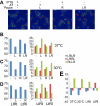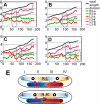Replication-directed sister chromosome alignment in Escherichia coli
- PMID: 20487299
- PMCID: PMC2859247
- DOI: 10.1111/j.1365-2958.2009.06791.x
Replication-directed sister chromosome alignment in Escherichia coli
Abstract
Non-replicating Escherichia coli chromosomes are organized as sausage-shaped structures with the left (L) and the right (R) chromosome arms (replichores) on opposite cell halves and the replication origin (oriC) close to midcell. The replication termination region (ter) therefore passes between the two outer edges of the nucleoid. Four alignment patterns of the two <LR> sister chromosomes within a cell have been detected in an asynchronous population, with the <LRLR> pattern predominating. We test the hypothesis that the minority <LRRL> and <RLLR> patterns arise because of pausing of DNA replication on the right and left replichores respectively. The data resulting from transient pausing or longer-term site-specific blocking of replication show that paused/blocked loci remain close to midcell and the normally replicated-segregated loci locate to the outer regions of the nucleoid, therefore providing experimental support for a direct mechanistic link between DNA replication and chromosome organization.
Figures




Similar articles
-
The two Escherichia coli chromosome arms locate to separate cell halves.Genes Dev. 2006 Jul 1;20(13):1727-31. doi: 10.1101/gad.388406. Genes Dev. 2006. PMID: 16818605 Free PMC article.
-
Dancing around the divisome: asymmetric chromosome segregation in Escherichia coli.Genes Dev. 2005 Oct 1;19(19):2367-77. doi: 10.1101/gad.345305. Genes Dev. 2005. PMID: 16204186 Free PMC article.
-
Independent positioning and action of Escherichia coli replisomes in live cells.Cell. 2008 Apr 4;133(1):90-102. doi: 10.1016/j.cell.2008.01.044. Cell. 2008. PMID: 18394992 Free PMC article.
-
The bacterial replisome: back on track?Mol Microbiol. 2008 Sep;69(6):1341-8. doi: 10.1111/j.1365-2958.2008.06378.x. Epub 2008 Jul 30. Mol Microbiol. 2008. PMID: 18673457 Free PMC article. Review.
-
Structural and physical aspects of bacterial chromosome segregation.J Struct Biol. 2006 Nov;156(2):273-83. doi: 10.1016/j.jsb.2006.04.013. Epub 2006 May 20. J Struct Biol. 2006. PMID: 16828313 Review.
Cited by
-
Segregation of chromosome arms in growing and non-growing Escherichia coli cells.Front Microbiol. 2015 May 12;6:448. doi: 10.3389/fmicb.2015.00448. eCollection 2015. Front Microbiol. 2015. PMID: 26029188 Free PMC article.
-
The progression of replication forks at natural replication barriers in live bacteria.Nucleic Acids Res. 2016 Jul 27;44(13):6262-73. doi: 10.1093/nar/gkw397. Epub 2016 May 10. Nucleic Acids Res. 2016. PMID: 27166373 Free PMC article.
-
Escherichia coli Chromosomal Loci Segregate from Midcell with Universal Dynamics.Biophys J. 2016 Jun 21;110(12):2597-2609. doi: 10.1016/j.bpj.2016.04.046. Biophys J. 2016. PMID: 27332118 Free PMC article.
-
Independent segregation of the two arms of the Escherichia coli ori region requires neither RNA synthesis nor MreB dynamics.J Bacteriol. 2010 Dec;192(23):6143-53. doi: 10.1128/JB.00861-10. Epub 2010 Oct 1. J Bacteriol. 2010. PMID: 20889756 Free PMC article.
-
The terminal region of the E. coli chromosome localises at the periphery of the nucleoid.BMC Microbiol. 2011 Feb 2;11(1):28. doi: 10.1186/1471-2180-11-28. BMC Microbiol. 2011. PMID: 21288323 Free PMC article.
References
-
- Espéli O, Mercier R, Boccard F. DNA dynamics vary according to macrodomain topography in the E. coli chromosome. Mol Microbiol. 2008;68:1418–1427. - PubMed
-
- Lau IF, Filipe SR, Søballe B, Økstad OA, Barre FX, Sherratt DJ. Spatial and temporal organization of replicating Escherichia coli chromosomes. Mol Microbiol. 2003;49:731–743. - PubMed
-
- Mercier R, Petit M-A, Schbath S, Robin S, El-Karoui M, Boccard F, Espéli O. The MatP/matS site-specific system organizes the terminus region of the E. coli chromosome into a macrodomain. Cell. 2008;135:475–485. - PubMed
-
- Michel B, Recchia GD, Penel-Colin M, Ehrlich SD, Sherratt DJ. Resolution of Holliday junctions by RuvABC prevents dimer formation in rep mutants and UV-irradiated cells. Mol Microbiol. 2000;37:180–191. - PubMed
Publication types
MeSH terms
Substances
Grants and funding
LinkOut - more resources
Full Text Sources

